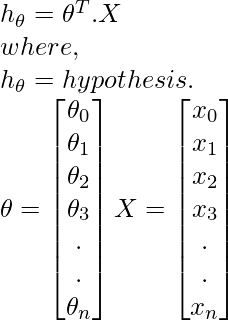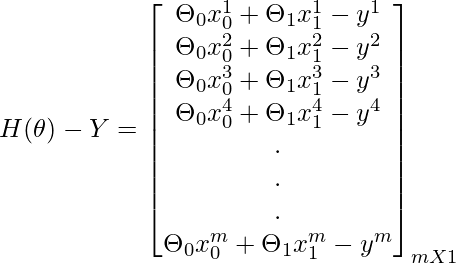Vectorization Of Gradient Descent
Last Updated :
24 Oct, 2020
In Machine Learning, Regression problems can be solved in the following ways:
1. Using Optimization Algorithms – Gradient Descent
- Batch Gradient Descent.
- Stochastic Gradient Descent.
- Mini-Batch Gradient Descent
- Other Advanced Optimization Algorithms like ( Conjugate Descent … )
2. Using the Normal Equation :
- Using the concept of Linear Algebra.
Let’s consider the case for Batch Gradient Descent for Univariate Linear Regression Problem.
The cost function for this Regression Problem is :

Goal:

In order to solve this problem, we can either go for a Vectorized approach ( Using the concept of Linear Algebra ) or unvectorized approach (Using for-loop).
1. Unvectorized Approach:
Here in order to solve the below mentioned mathematical expressions, We use for loop.
The above mathematical expression is a part of Cost Function.

The above Mathematical Expression is the hypothesis.
 Code: Python Implementation of Unvectorzed Grad
Code: Python Implementation of Unvectorzed Grad
from sklearn.datasets import make_regression
import matplotlib.pyplot as plt
import numpy as np
import time
x, y = make_regression(n_samples = 100, n_features = 1,
n_informative = 1, noise = 10, random_state = 42)
plt.scatter(x, y, c = 'red')
plt.xlabel('Feature')
plt.ylabel('Target_Variable')
plt.title('Training Data')
plt.show()
y = y.reshape(100, 1)
num_iter = 1000
alpha = 0.01
m = len(x)
theta = np.zeros((2, 1),dtype = float)
t0 = t1 = 0
Grad0 = Grad1 = 0
start_time = time.time()
for i in range(num_iter):
for j in range(m):
Grad0 = Grad0 + (theta[0] + theta[1] * x[j]) - (y[j])
for k in range(m):
Grad1 = Grad1 + ((theta[0] + theta[1] * x[k]) - (y[k])) * x[k]
t0 = theta[0] - (alpha * (1/m) * Grad0)
t1 = theta[1] - (alpha * (1/m) * Grad1)
theta[0] = t0
theta[1] = t1
Grad0 = Grad1 = 0
print('model parameters:',theta,sep = '\n')
print('Time Taken For Gradient Descent in Sec:',time.time()- start_time)
h = []
for i in range(m):
h.append(theta[0] + theta[1] * x[i])
plt.plot(x,h)
plt.scatter(x,y,c = 'red')
plt.xlabel('Feature')
plt.ylabel('Target_Variable')
plt.title('Output')
|
Output:

model parameters:
[[ 1.15857049]
[44.42210912]]
Time Taken For Gradient Descent in Sec: 2.482538938522339

2. Vectorized Approach:
Here in order to solve the below mentioned mathematical expressions, We use Matrix and Vectors (Linear Algebra).
The above mathematical expression is a part of Cost Function.

The above Mathematical Expression is the hypothesis.

Batch Gradient Descent :

Concept To Find Gradients Using Matrix Operations:





 Code: Python implementation of vectorized Gradient Descent approach
Code: Python implementation of vectorized Gradient Descent approach
from sklearn.datasets import make_regression
import matplotlib.pyplot as plt
import numpy as np
import time
x, y = make_regression(n_samples = 100, n_features = 1,
n_informative = 1, noise = 10, random_state = 42)
plt.scatter(x, y, c = 'red')
plt.xlabel('Feature')
plt.ylabel('Target_Variable')
plt.title('Training Data')
plt.show()
X_New = np.array([np.ones(len(x)), x.flatten()]).T
y = y.reshape(100, 1)
num_iter = 1000
alpha = 0.01
m = len(x)
theta = np.zeros((2, 1),dtype = float)
start_time = time.time()
for i in range(num_iter):
gradients = X_New.T.dot(X_New.dot(theta)- y)
theta = theta - (1/m) * alpha * gradients
print('model parameters:',theta,sep = '\n')
print('Time Taken For Gradient Descent in Sec:',time.time() - start_time)
h = X_New.dot(theta)
plt.scatter(x, y, c = 'red')
plt.plot(x ,h)
plt.xlabel('Feature')
plt.ylabel('Target_Variable')
plt.title('Output')
|
Output:

model parameters:
[[ 1.15857049]
[44.42210912]]
Time Taken For Gradient Descent in Sec: 0.019551515579223633

Observations:
- Implementing a vectorized approach decreases the time taken for execution of Gradient Descent( Efficient Code ).
- Easy to debug.
Like Article
Suggest improvement
Share your thoughts in the comments
Please Login to comment...